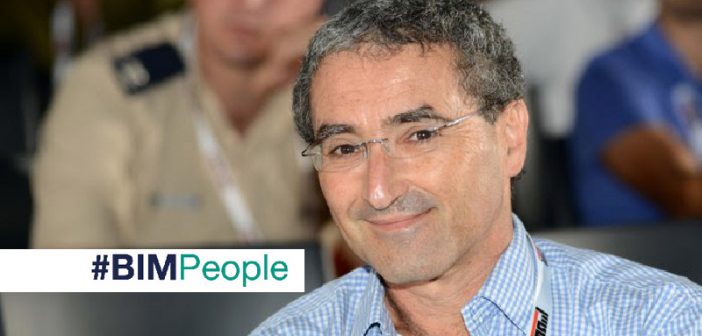Rafael Sacks, Professor at Technion, is an expert in BIM and Lean Construction. His research is prolific and he has co-authored the “BIM Handbook” and the upcoming “Building Lean, Building BIM”.
BIMIreland.ie spoke to Rafael about his research in BIM and Lean Construction, BIM adoption and what countries have impressed him, and his opinion of the Irish BIM Innovation Awards projects.
Rafael received a bachelor’s degree in 1983 from the University of the Witwatersrand, his master’s in 1985 from the Massachusetts Institute of Technology, and his doctorate in 1998 from the Technion – all in Civil Engineering. He has worked as a structural engineer, CAD software developer, and construction project manager, and consultant to industry and government clients. He joined Technion in 2000 and served as Head of Structural Engineering and Construction Management. He has received many awards for research and teaching.
Can you tell us about your work in BIM?
I work in BIM research. We are always looking at the next best thing, into what BIM can do for designers and builders. We look at the big problems and seek opportunities to apply our knowledge and find solutions. We try to push the envelope in new ways of working.
I started working for an Autodesk registered developer in the 1990s. At that time BIM was an idea, and we were developing 3D objects working in AutoCad. In 2000 Revit was introduced, and it was only then we had tools to do what we wanted in the manipulation of objects. The term “Building Information Modelling” became familiar from 2003 or 2004 onwards. BIM interoperability became big at this time and we worked on the exchange of models between software systems.
Our key research area in BIM nowadays is semantic enrichment. We are looking at computer software taking models and adding information which is missing and making them available for use by other software. This involves artificial intelligence, rule-based processing and machine learning. Using BIM on existing buildings is now a big topic, using laser scanning to create a point cloud and create a model. We are doing research on taking point clouds and creating regular BIM models from them, where we use machine learning and semantic enrichment and turn them into 3D geometry and then recognise the 3D geometry as meaningful objects and create a model. We are doing a lot of work in this area.
Please tell us about your industry collaborations?
We have research collaborations with software companies and construction companies. We work with software companies to solve their problems, and to provide a window into the next steps in BIM technology and practice. We work with contractors to provide real world solutions to projects, often using their construction projects as living laboratories. We get to undertake research and they get their problems addressed.
Please tell us more about your BIM research and your combination of BIM and Lean Construction?
Having conducted research in both BIM and Lean, it became clear to me some ten years ago that we could find synergies between Lean and BIM. During a sabbatical at the University of Reading in the UK from 2008-2009, I had the chance to explore these ideas, and we did research exploring flow using BIM and Lean. The following year, we produced a software prototype called KanBIM, which was an attempt to guide and control production on site using the BIM model as an information hub.
In one project here we collaborated with a leading, innovative contractor to apply both Lean thinking and BIM in construction and customization of apartments. The idea was to separate the standard parts and the customised parts, separating the building systems and using BIM models to explicitly show every feature of the building and any changes requested by the client. The BIM model is the repository of the information and the mechanism for creating pull flow control. Our new book, “Building Lean, Building BIM” will feature this collaborative research project. We describe a great deal of what this company has done to implement Lean and BIM.
What are the significant research areas and topics in BIM at present?
I would say using offsite/modularisation/prefabricated construction and BIM. This allows us to create models in BIM which are a true reflection of what is on site. I would also say laser scanning, AR and VR and smart systems. In Israel, specifically, doing automated code compliance checking is about to become a topic in high demand. I have a PhD student who is working on code compliance checking, using semantic enrichment to automatically pre-process models for checking. This area will become very significant all around the world. Data mining, comparing data collected by sensors installed in buildings in the real world to results in BIM model simulations to find out how buildings really work, is another development that will become a big research area.
How do you think the BIM and Lean Construction approaches will influence each other and how can they revolutionise the international construction industry?
Although they are difficult to initiate, Lean and BIM practices are reducing costs and eliminating waste everywhere they are adopted effectively. I understand that the construction ecosystem in Ireland has adopted both quicker than a lot of countries around the world. I know from the CitA presentations and projects that the work is very impressive.
What is your advice for contractors and consultants who are using BIM and now want to adopt Lean?
Read, read, read! Read books and papers and visit companies who have made progress. A study of companies implementing Lean and BIM can motivate people to adopt both approaches. It provides people with the understanding of what they will have to do and the culture change that will occur.
How is BIM adoption progressing in Israel?
We are comparable to Ireland in population. We have a small land area. Most of the big construction is centered in the big cities. The adoption of BIM has been slow, there have been few pioneers, but these have been leaders in our BIM adoption. The big contractors are influencing smaller companies. The Israeli Ministry of Defence has issued a BIM Mandate and this has influenced a lot of companies to undertake training and buy software. We are seeing a lot of start-up companies appearing who are developing applications for using technology in construction: drones, data mining, machine learning, robotics etc.
How do you think governments should best approach BIM Implementation?
There are three main approaches. The UK model is the client approach, where they come at it like a client, they are the money. They say what they want.
The second approach is typified by Singapore, whereby they help the industry by providing money for innovative solutions. They prime the companies with money.
The third approach is the laissez-faire approach, whereby you say “Let the free market take care of it.” This is what has happened in Israel.
What countries currently impress you with their BIM plans?
Finland, US, UK, Ireland, and Singapore. The Finnish Government had the insight to invest in R&D. They had a number of start-up companies who became successful. They had great projects. In the US, Integrated project delivery (IPD) and an innovative pioneering spirit, the scale of the industry and investment have driven BIM there. In Singapore and the UK, the governments have driven BIM with initiatives. In Ireland, the contractors and consultants have gone ahead and adopted BIM on projects and have been doing a number of great projects. They have taken a leap of faith and have gone ahead and performed well.
In the BIM Handbook we covered the Aviva Stadium in Dublin and we had this as a lead case study. There were projects from around the world, and this was on the book’s front cover. This was a great example of using BIM on a project. In the third edition of the book, we will have another Dublin project: The New Children’s Hospital. With regards BIM, this is amazing considering Ireland is a small country.
When do you think BIM will be the common approach to public projects across the EU?
We know now that there is a stronger EU working group for BIM. Some of the EU countries are very advanced. Countries like the UK, Ireland, Germany, Italy and Sweden are ahead of the others. There are some good initiatives in the countries in Central and Eastern Europe.
Has international BIM adoption been a success so far in your opinion?
A lot of work has been done. But there is a long way to go. BIM should improve the quality of designs before the projects go to site. Things like structural analysis and cost analysis – there is a long way to go to be able to simulate what we are going to build and then use the data in the design of the real structure.
In many countries, BIM adoption is being led by contractors. Over time I think we will see BIM and Lean leading to a way of reducing the cost of projects with the use of technology.

When Alan Hore calls up and says “I need you to help with judging,” I say alright. In a reciprocal vein, I am a co-chair of the LC3 2017 BIM and Lean conference in Crete later this year, and Alan is the coordinator of the BIM and Lean Innovation Competition that we will hold as part of the industry day at the conference. The event, which runs over eight days from 4 – 12 July 2017, is for designers, construction companies, academics and researchers. It integrates three conferences (Computing in Construction, VR in Construction and Lean Construction), two PhD summer schools, one industry day and a variety of social and networking opportunities. More information can be found at www.lc3-2017.com.
You were a judge for the Irish BIM Innovation Awards. What was your opinion of the projects?
They were excellent. They were very sophisticated. There were some great projects: a data centre, schools, and refurbishments. They went far in the collaborative nature of projects.
The contents of this site are subject to copyright laws and may not be reproduced in any form without the prior consent of the publishers. The views expressed in articles do not necessarily represent those of the publishers.




